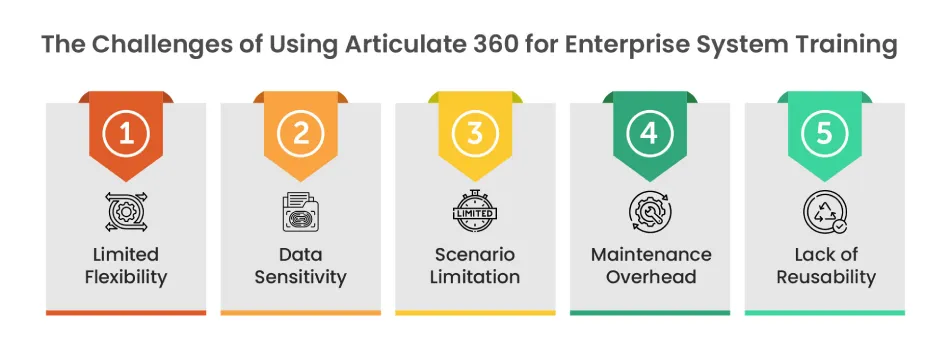Introduction
In today’s digital landscape, businesses need more than traditional eLearning tools to keep employees trained and agile. With software systems evolving rapidly, training platforms must go beyond static content to deliver hands-on experiences, accelerate user adoption, and scale with organizational growth.
Articulate 360 is widely known for creating foundational and immersive eLearning content. However, many enterprises find it limiting when it comes to large-scale, interactive, system-based training.
Assima offers a dynamic, enterprise-focused approach. With solutions that allow organizations to create editable simulations, deliver real-time in-app guidance, and scale effortlessly, Assima empowers employees to learn by doing—resulting in faster adoption, fewer errors, and stronger knowledge retention.
The Challenges of Using Articulate 360 for Enterprise System Training
While Articulate 360 remains a go-to for content-driven learning, it presents challenges for complex enterprise system training.
Why Static Captures Don’t Scale
Articulate’s screen capture approach relies on static images or video recordings of an application, meaning the captured content is not inherently editable. This creates several issues:
Limited Flexibility
If a software interface changes—even slightly—authors must re-record or rebuild entire sequences, which is time-consuming and inefficient.
Data Sensitivity
Since screen captures are fixed images, removing or masking sensitive information (e.g., names, account numbers, proprietary data) is difficult without blurring or starting over.
Scenario Limitation
Creating multiple training scenarios (e.g., different user roles or outcomes) often requires capturing the same process repeatedly, increasing workload and version control complexity.
Maintenance Overhead
Static content becomes outdated quickly. Without editable simulations, teams using Articulate face ongoing maintenance challenges as small UI changes in the live system can render materials obsolete.
Lack of Reusability
Because content can't be modularly updated or reused easily, it's difficult to scale training across teams, departments, or regions efficiently.

Gaps in Real-Time Support and Scalability
Enterprise rollouts often span thousands of users across multiple regions and require scalable, context-aware training solutions. While Articulate 360 excels at building static eLearning modules, it lacks real-time, in-app guidance and advanced analytics tied to live system usage, features essential for driving adoption and measuring training effectiveness at scale.
Why Assima Is Built for Enterprise Success
Assima’s innovative software simulation technology and user adoption tools are designed specifically for enterprise system training.
Interactive, Editable Simulations
Assima captures each on-screen object individually, right down to the smallest fields and buttons. This enables authors to edit screen elements, remove sensitive data, and build multiple training scenarios from a single clone. Since the content is fully editable, it can be quickly updated to reflect software changes, keeping training materials accurate, reusable, and future-proof.
Real-Time, In-App Guidance
Assima delivers contextual help directly within the application. As users navigate the live system, Assima provides step-by-step guidance that reduces support tickets and prevents workflow interruptions.
- Boost productivity with on-the-job guidance
- Support users at the point of need, not after the fact
Enterprise-Ready Scalability
Designed for large organizations, Assima supports thousands of users and integrates seamlessly with your digital ecosystem. Its cloud-based infrastructure enables global training deployment without burdening IT.
- Standardize training across regions
- Monitor adoption and performance with detailed analytics
Feature Comparison: Assima Train vs. Articulate 360
Feature | Assima Train | Articulate 360 |
Editable Simulations | ✅ Yes | ❌ No |
Real-Time In-App Guidance | ✅ Yes | ❌ No |
Enterprise Scalability | ✅ Yes | ⚠ Limited |
Analytics & Reporting | ✅ Yes | ❌ No |
The Assima Advantage: Designed for the Modern Enterprise
- Faster User Adoption: Learn by doing, not just watching.
- Higher ROI: Reuse and update training without rebuilding from scratch.
- Reduced Support Costs: In-app guidance reduces reliance on help desks.
- Smarter Decisions: Data-driven insights into user behavior and skill gaps.
Case Study: How Assima Transformed Training at Société Générale
- When Société Générale, one of the world’s top banks, needed to accelerate software adoption and support its digital transformation, it turned to Assima.
- Results Achieved:
- 50% Reduction in Training Time – Employees adopted new systems in half the time.
- 40% Boost in Knowledge Retention – Hands-on simulations improved long-term memory.
- Significant Cost Savings – Reusable content reduced retraining needs.
- Improved Compliance & Risk Management – Safe environments minimized errors.
- Global Scalability – Standardized training across countries and teams.
By switching to Assima, Société Générale ensured faster software adoption, minimized errors, and empowered its workforce to be more efficient in a rapidly evolving financial landscape.
Conclusion
While Articulate 360 is a well-known and widely used eLearning tool, it is primarily designed for general content authoring. For organizations looking to deliver highly interactive and scalable enterprise software training, Assima offers a specialized solution. With features like editable software simulations, in-app guidance, and enterprise-wide scalability, Assima empowers businesses to enhance software proficiency, reduce training costs, and accelerate user adoption.
Learn how Assima Train can help your global workforce onboard smarter.
Frequently Asked Questions
Let’s Answer Some of Your Questions.
Multilingual e-learning ensures that employees from different linguistic backgrounds receive consistent, understandable, and effective training, boosting retention, productivity, and engagement.
Assima Train offers real-time language switching, simulation cloning for fast localization, and low-code deployment, making it easy to deliver consistent multilingual training at scale.
Yes, training employees in their native language reduces cognitive load, improves comprehension, and significantly accelerates onboarding times.
Industries with global operations, such as healthcare, retail, technology, finance, and manufacturing, benefit greatly from multilingual e-learning.
Simulation offers hands-on, interactive learning that mimics real-world applications, helping learners understand systems better and faster, regardless of the language they speak.